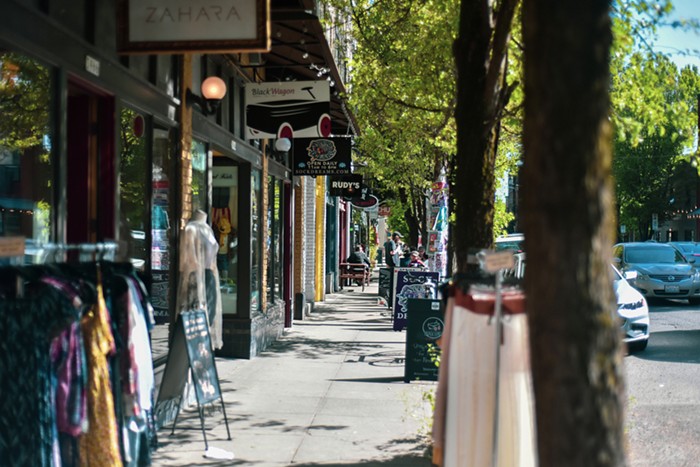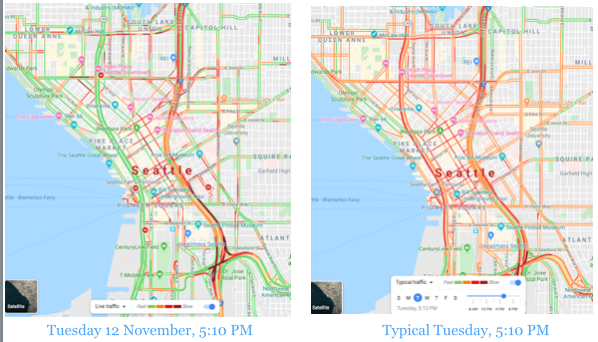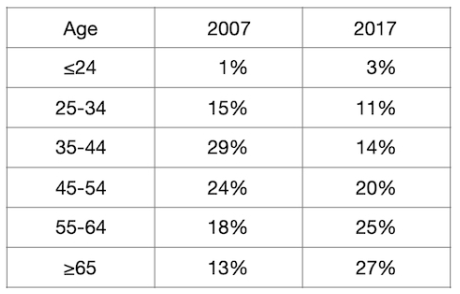What City Observatory did this week
1. Copenhagen’s cycling success hinges on tax policy and pricing, not just bike lanes. The New York Times offers up yet another postcard view of cycling in Copenhagen, where riding a bike to school or work is the most common mode of transportation. The Times reports that this is because cycling is just “easier” and “more convenient” due to the city’s extensive networks of bike lanes. That’s true, but leaves out an important part of the story. In Copenhagen, new cars are heavily taxed (a 150% sales tax), and gasoline costs more than $6 per gallon. In addition, parking is in short supply, and the city is raising the price of parking to further discourage car use. It’s also critical to recognize that the city’s compact development pattern means more common destinations are close-at-hand, making cycling a viable means of transportation for daily trips. By all means, lets build more bike lanes; but getting a more balanced transportation system also depends critically on asking cars to pay something close to the full social, environmental, and economic costs they impose on all of us.
2. Carmaggedon is a no-show in Seattle once again. Earlier this year, when Seattle shut down its crumbling Alaskan Way viaduct, traffic experts widely predicted gridlock, expecting more than 90,000 cars to divert to city streets. That didn’t happen, and in fact traffic levels were subdued. The same predictions were made about the effects of turning on tolling on the new $3 billion SR 99 downtown tunnel (the roadway built to replace the viaduct). Traffic engineers predicted a third or more of tunnel users would divert to city streets, producing Carmaggedon. Once again, the predictions were wrong, at least as evidenced by Google Maps contemporaneous reporting of road conditions.
What Seattle’s experience shows–again–is that measures that reduce road capacity, or price roadways, actually reduce traffic levels. It’s the opposite of “induced demand”–reducing highway capacity in the city reduces the number of cars flowing onto city streets, and enables the transportation system to work better. The naive models that highway engineers peddle, implying that traffic is an inexorable, tidal force, are simply wrong. If you want less traffic and congestion, price roads and constrain highway capacity.
3. The city as a labor saving device. Some of the most powerfully transformative technologies have been those that save human labor; indoor plumbing, washing machines, refrigerators, vacuum cleaners and the like have all reduced dramatically the amount of domestic work, and given us more leisure time. While we don’t think of cities as a “technology,” a dense, mixed-used urban neighborhood is actually a big time saver. With more common destinations (grocery stores, coffee shops, restaurants, and friends) close at hand, cities can be a big time saver. A big part of the demand for urban living comes from households looking to live in places that save them the one form of wealth you can’t get more of: time.

Must read
1. The limits of micro-transit. The problem with buses, rail lines, and other “fixed route” transit, is that unless you live at a station or bus-stop, and all your destinations are adjacent to stops, you have to walk to and from the place the transit serves. One regularly imagined solution to this problem is the idea of micro-transit: small vehicles that would ply varying routes, picking up people at their homes or orgins in one area, and then ferrying them to a common destination (or destinations). In theory, that ought to eliminate pesky walking, and given enough trip density (and computerized scheduling) it ought to be possible to pool multiple trips with a single vehicle. The trouble with that idea, though (as Human Transit’s Jarrett Walker has frequently pointed out, is that is inefficient and expensive. For those who are looking for a succinct statement of what microtransit is (mostly) a dead-end, they have a new policy brief that makes that case. Here’s a excerpt:
Picking people up at their doorstep involves traveling greater distances than operating service along a fixed route, and a microtransit driver in a van or car can carry far fewer people than the operator of a bus or train. For these reasons, microtransit typically costs agencies much, much more to run than an average bus route. And while subsidies for bus and train service fall as more people ride, microtransit is locked into a high-cost format that consumes more subsidies as usage increases.
2. Why more cyclists are dying. The National Transportation Safety Board has just reported the grim death tally for 2018: Some 857 cyclists were killed on the road, the highest number in decades. In the face of a roundly (and justifiably) criticized call by the NTSB to make helmets mandatory, Bicyclist has a thoughtful look at the reasons why cyclists deaths are increasing. By identifying the causes of deaths, this analysis points to a more reasonable set of recommendations for reducing the toll. Chief among the causes: more people are driving more miles (we might add, due to cheaper gasoline), more drivers are distracted by technology like smart phones, and more of the cars on the road are especially lethal trucks and truck-like SUVs. It’s also true that more people are cycling than in previous years, but it appears the “safety-in-numbers” effect of more regularly encountering cyclists has been more than offset by the other negatives. As a result, cities who only a short while ago adopted great-sounding goals around Vision Zero, have seen this particular metric going in the wrong direction.
3. New cars are for old people. Michael Sivak has an interesting analysis in the shift in the demographics of car buyers in the past decade. Sales data show that new car buyers are proportionately older than ever. Sivak reports that 52 percent of all car buyers are 55 or older. Only 28 percent of car buyers are under age 45, down from 45 percent of all buyers just a decade ago. Much of this trend is driven by the overall aging of the population (millions more baby boomers are turning 65 every year), but much of it is evidence of the declining interest (and perhaps purchasing power) of young buyers.
New Knowledge
More evidence of the ineffectiveness of rent control. Around Germany, municipalities have implemented new rent control regimes in the past few years, and the roll-out of the program has provided researchers with a natural experiment for testing the actual effects of rent control against the theoretical predictions. Three researchers, Andreas Mense, Claus Michelsen & Konstantin Cholodilin, gathered data on the offering rents for apartments in German cities.
As the authors relate, much as in the United States, the growing interest in urban living has fueled youth migration to cities, which has led to a shortage of housing and an increase in rents. This was the proximate cause of legislation authorizing local rent caps.
. . . since 2010, urban agglomerations have become more attractive. Thanks to an inflow of migrants from smaller cities and from abroad, the population of large German cities began to expand quickly. The result was a housing shortage, particularly putting pressure on rents for new contracts
Like many rent control systems, the German approach regulates the rents of some units, but not others. One of the key findings of this study is that while units under rent control are less expensive, rents go up even more in the uncontrolled sector. In addition, rent control isn’t “means tested” meaning that people can benefit from rent control regardless of income. One of the theoretical predictions of economics is that rent control will tend to artificially discourage people from moving to a new home.
They find that:
. . . regulated rents decreased immediately after the rent cap became effective, while rents in the free-market segment increased after a lag of one to two months . . . an increase in free-market rents in response to rent control is a clear sign of misallocation of households to housing units . . .
Rent control allows some households, which otherwise would have been unwilling to rent a unit in the market, to compete for rent-controlled units, thereby replacing other households with higher willingness to pay. The latter households move to the free-market segment and bid up the price there.
Mense, Andreas; Michelsen, Claus; Cholodilin, Konstantin. Rent control, market segmentation, and misallocation: Causal evidence from a large-scale policy intervention, 2019. FAU Discussion Papers in Economics, No. 06/2019, Friedrich-Alexander- Universität Erlangen-Nürnberg, Institute for Economics, Erlangen
In the News
The New York Times quoted City Observatory’s report Less in Common in their article “Are my neighbor’s spying on me?”



